The best waterproof MTB jacket you can buy
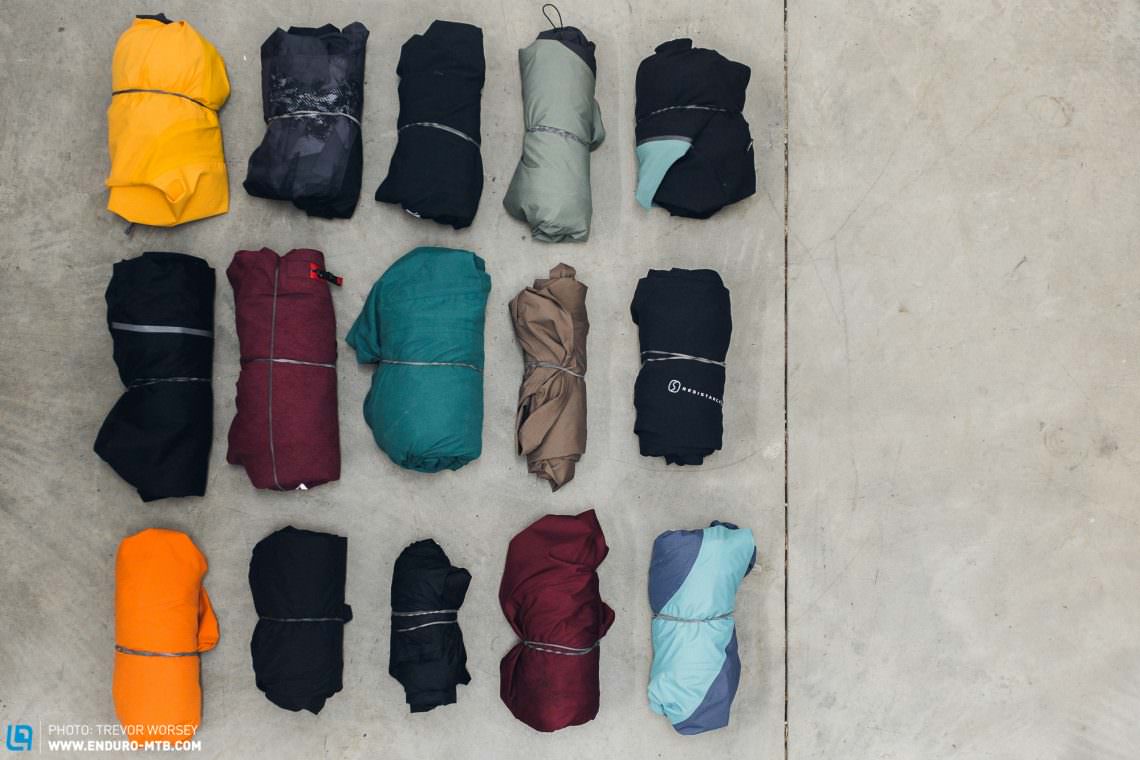
Winter sucks, fact! To best enjoy the wet season, you have to keep it outside of your jacket. We test 13 of the best waterproof jackets to see which ones can keep you dry.
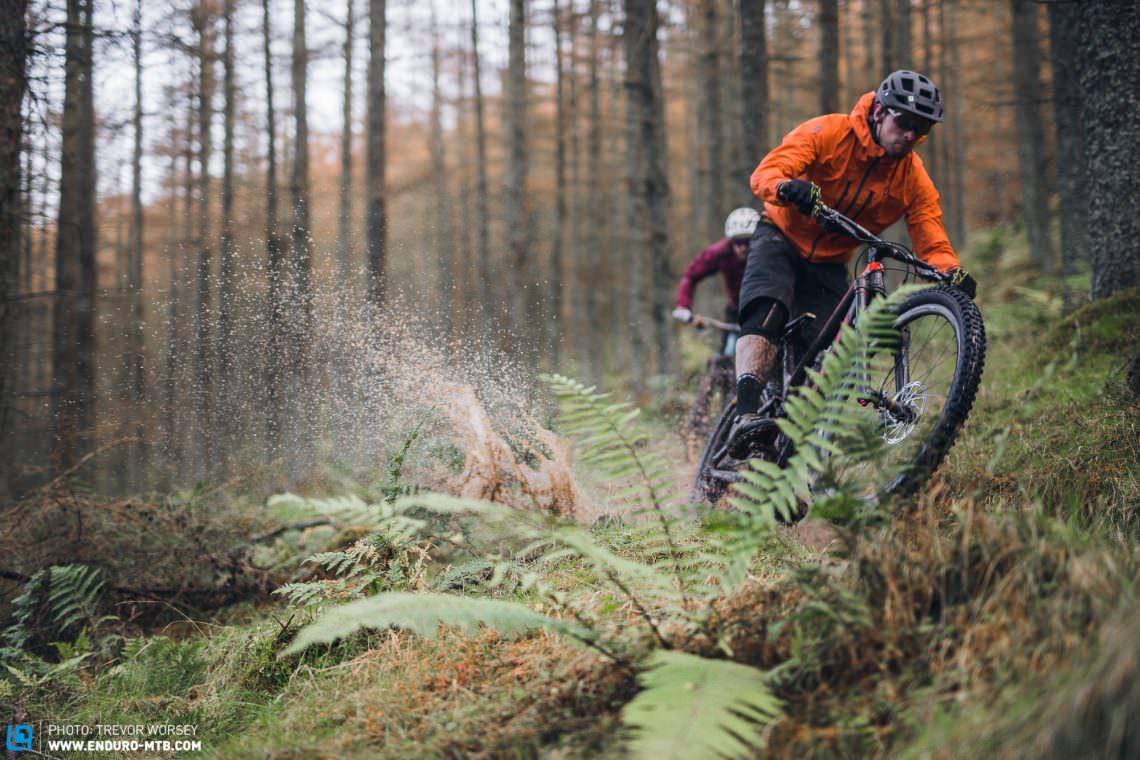
We’ve all heard the saying, “there is no such thing as bad weather, only bad clothing”. Well anyone who says that has never experienced their face being blasted by rain while clinging to the side of a mountain by their fingertips – sometimes the weather is just shit. In these situations a good jacket can be the difference between a humorous failure and a dangerous situation, especially in the colder months.
What makes a jacket waterproof
Generally there are two types of weather protection. Water Resistant jackets are treated with a Durable Water Repellency (DWR) coating that causes water to bead and run off. Water resistant jackets are more affordable, and many use a softshell fabric that can be very breathable. However, over time the DWR coating will wear off and need to be recoated. More expensive membrane based jackets have a membrane sandwiched between the layers – commonly three – which contains tiny pores. The membrane has microscopic pores that are big enough to let vapor (sweat) out from inside, but too small to let in big water drops. In fact the pores are around 20,000 times smaller than a water drop. It’s important to never wash expensive membrane jackets in fabric softener as it can block the pores. Popular membranes like GORE-TEX are breathable and offer great protection against the rain, but the cost is higher.
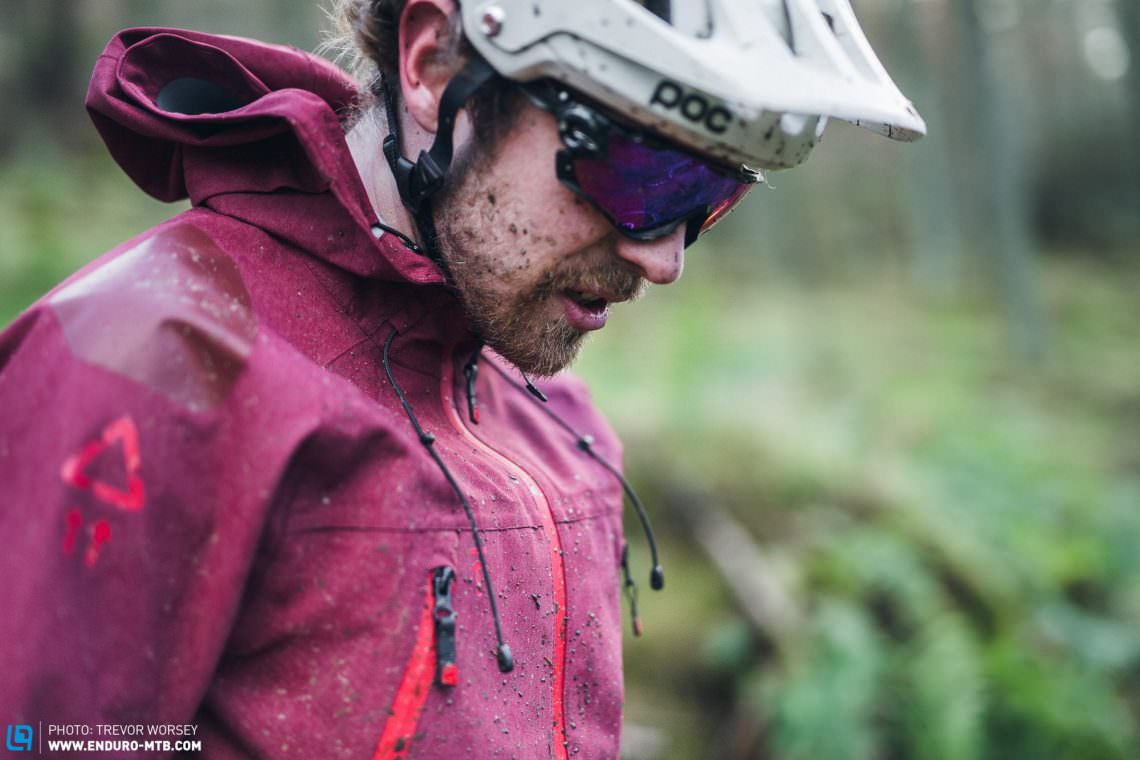
How waterproof is waterproof?
When looking at jackets you will see a host of confusing numbers, for example imagine a jacket that’s waterproof to 10,000 mm and breathable to 12,000 g/m2, what the hell does that mean? It means you could put a square 1×1 inch tube over the fabric and fill it to 10,000 mm (10 meters) before water will be forced through. The higher the number, the more waterproof the jacket. When it comes to breathability, the 12,000 g/m2 means it can shift 12,000 g of water from the inside to the outside per square meter of fabric over 24 hours. Again, the higher the number the more breathable, and probably expensive, the jacket. However, while a high rating is a good thing in the laboratory, on the trail we often find that the cut, design and venting are far more influential on the jacket’s performance.
Taped seams, critical or full?
It’s important to buy a jacket with taped seams. This means that all the tiny holes made by the sewing machine are taped, preventing water leaking through at these critical points. The best jackets will be ‘fully taped’ where all the seams are protected, which cheaper jackets will be ‘critically taped’ with only the shoulder and back seams protected.
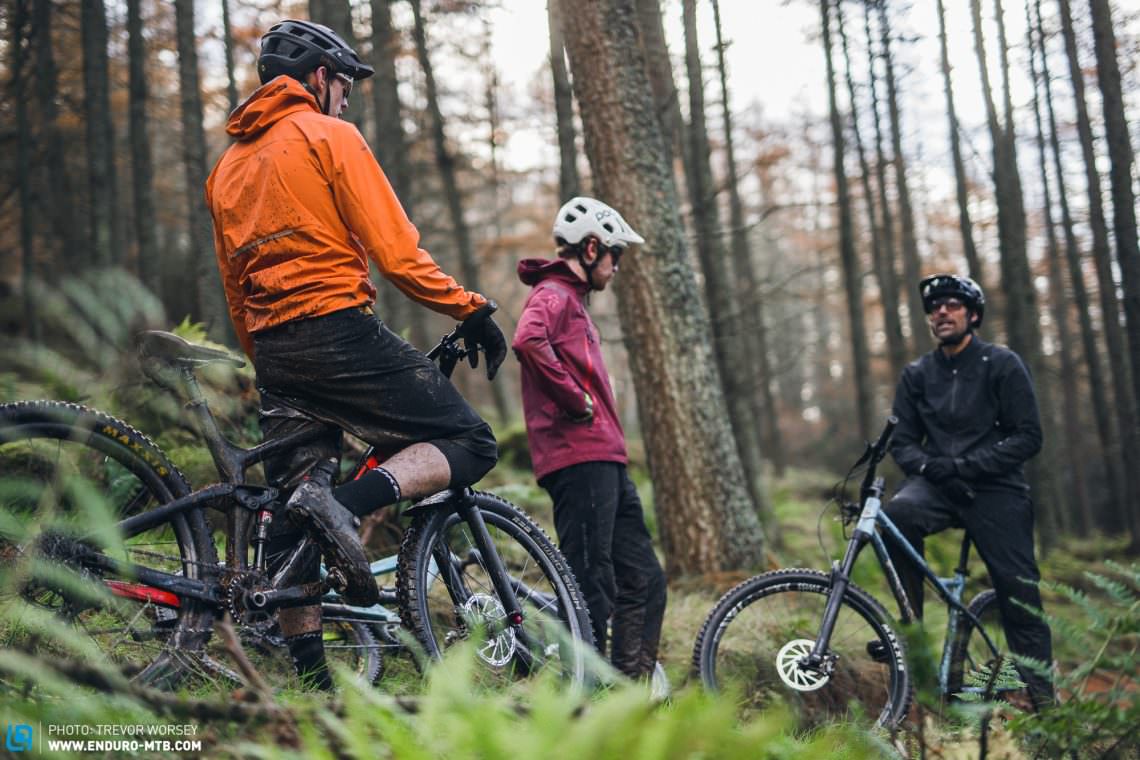

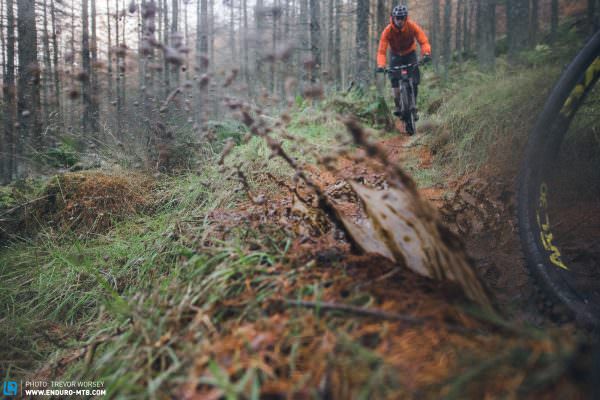
Fit and form, beauty is in the eye of the beholder
Jackets for mountain biking benefit from a different fit from other sports. Most jackets now have an anatomical fit, where the sleeves and back are a little longer to provide coverage in the normal riding position. While we don’t need a drop-tailed jacket like a stretched-out roadie, a well fitting trail jacket should have an athletic cut, with enough flex or material around the shoulders for dynamic riding, without being so loose that it flaps in the wind. Some jackets now feature high stretch fabric for added comfort.
Up with the hood
No matter how waterproof your jacket, if you ride in heavy rain without a hood, your jacket will fill up like a water balloon. Most of the jackets in this group test have hoods, some fit under the helmet and some fit over. For trail riding we prefer highly adjustable hoods that are cut more generously to fit over a helmet for the quickest and most effective protection.
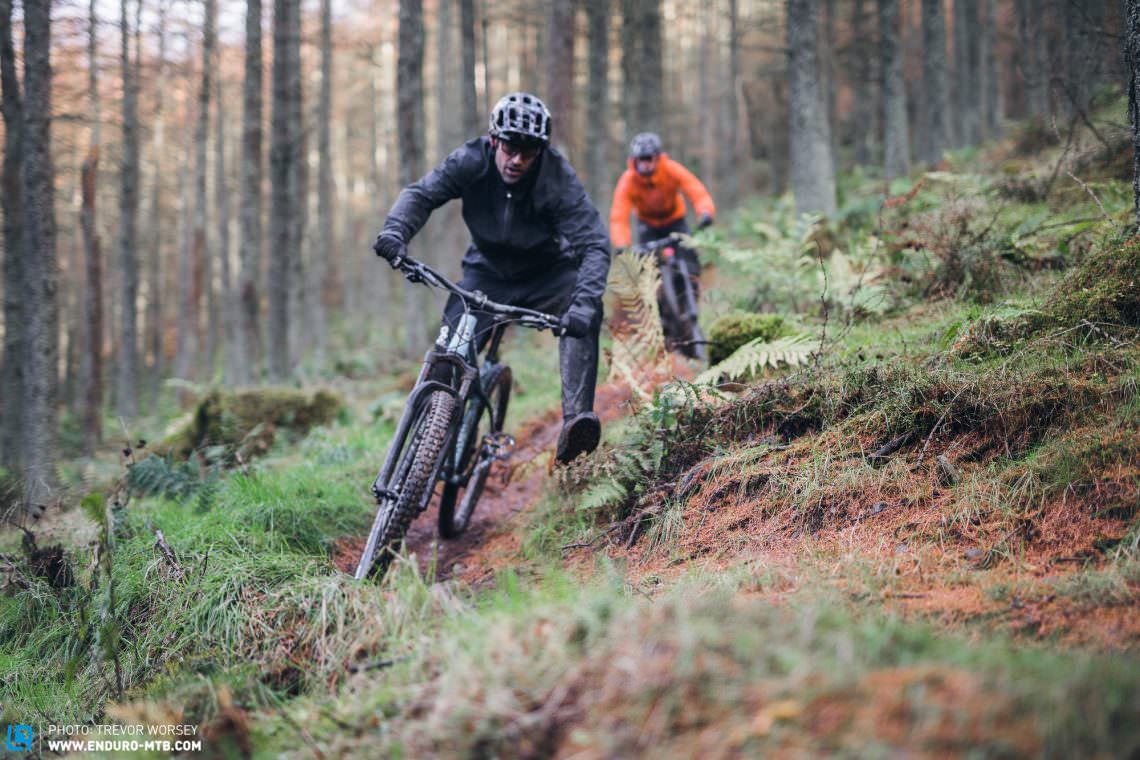
Don’t boil in the bag, it’s all about the vents
It’s not always cold when it’s raining, and no matter how breathable your jacket, a decent hill can have you sweating more than a long-tailed cat in a room full of rocking chairs. Cycling is hard work, and vents can provide far more ventilation than a membrane. The best jackets have vents that can be unzipped to allow air to flow freely around the jacket, under the arms and on the chest. The faster the air is changed inside the jacket, the less moisture builds up and the dryer you stay. Be suspicious of vents on the back though, as these are normally ineffective when wearing a rucksack.
What about the onesie?
If you really love getting out in filthy conditions we would make two suggestions. First, you really should check out the latest onesies from Endura and Dirtlej – both take all-weather protection to the next level. Without a vulnerable gap between the trousers and jacket, protection from the elements is absolute, but they are far less versatile than the separate parts they replace and double the risk of expensive damage in the case of a crash. And secondly, if you love filthy conditions so much, you should quite possibly be seeking psychological help.
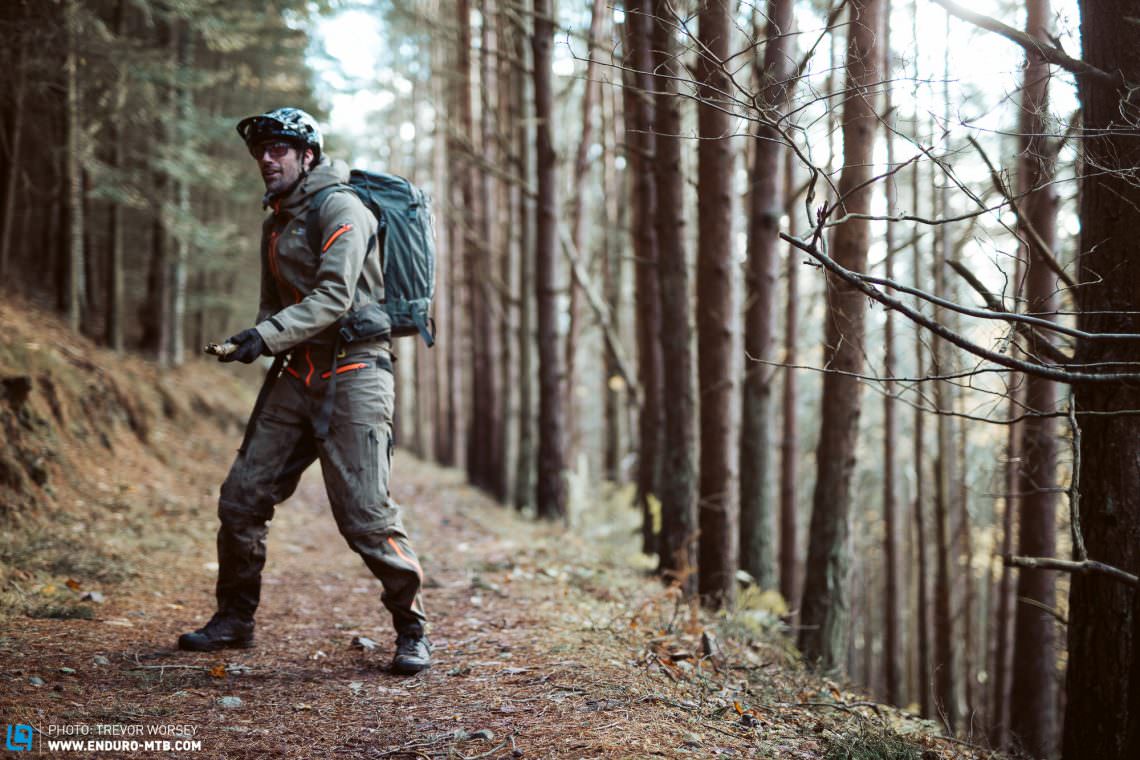
What’s in your pockets
If you plan to carry a phone and map in your jacket, be sure to choose one with big pockets. We especially like jackets with a zipped compartment so you don’t end up dropping your phone in the mud every time you fish around for an emergency jelly baby. However, we prefer jackets with minimal pockets as overloading the jacket with heavy gear makes it very uncomfortable when riding.
Colour, more than just black and white
We all love tech black, living out our ‘special forces’ fantasies. If your jacket is for shredding home trails and smashing down pints after the ride, then any colour goes. But if you plan to head out into the big mountains a bright colour will go a long way to keeping you visible and safe!
The test group
So what makes a perfect waterproof jacket? It’s all about balance. Realistically, the jacket will live predominantly in your backpack, ready to be deployed if the weather turns nasty, so a low weight and being able to compress the jacket to a minimal packsize is very important. A good jacket is a serious investment so it should be versatile, protective enough to survive a winter storm, but airy enough to be functional in the warmer months. We reached out to all the key brands and asked them to send their best all-rounder, where high-performance meets functionality.
| Model | Price | Weight | Waterproof rating (mm) | Breathability rating (g/m²) |
|---|---|---|---|---|
| Endura MT500 II | € 229.99 | 500 g | 18,000 | 64,000 |
| Endura Singletrack II | € 129.99 | 420 g | 10,000 | 20,000 |
| FOX Attack Pro Water Jacket | € 229.95 | 380 g | 15,000 | 25,000 |
| GORE C5 Active Trail</td> | € 269.95 | 270 g | 28,000 | 18,000 |
| ION SCRUB AMP | € 249.99 | 410 g | 20,000 | 20,000 |
| ION TRAZE SELECT | € 199.95 | 480 g | 20,000 | 20,000 |
| Leatt DBX 5.0 | € 199.99 | 680 g | 30,000 | 23,000 |
| Madison DTE Storm Jacket | € 185.00 | 620 g | 20,000 | 20,000 |
| Maloja AndriM | € 269.90 | 240 g | 25,000 | / |
| POC Resistance Pro Enduro | € 350.00 | 530 g | / | / |
| SCOTT Trail MTN Dryo 20 | € 239.00 | 490 g | 15,000 | 15,000 |
| Specialized Deflect H20 | € 199.00 | 330 g | / | / |
| Sweet Protection Hunter DryZeal | € 199.00 | 210 g | 10,000 | 10,000 |
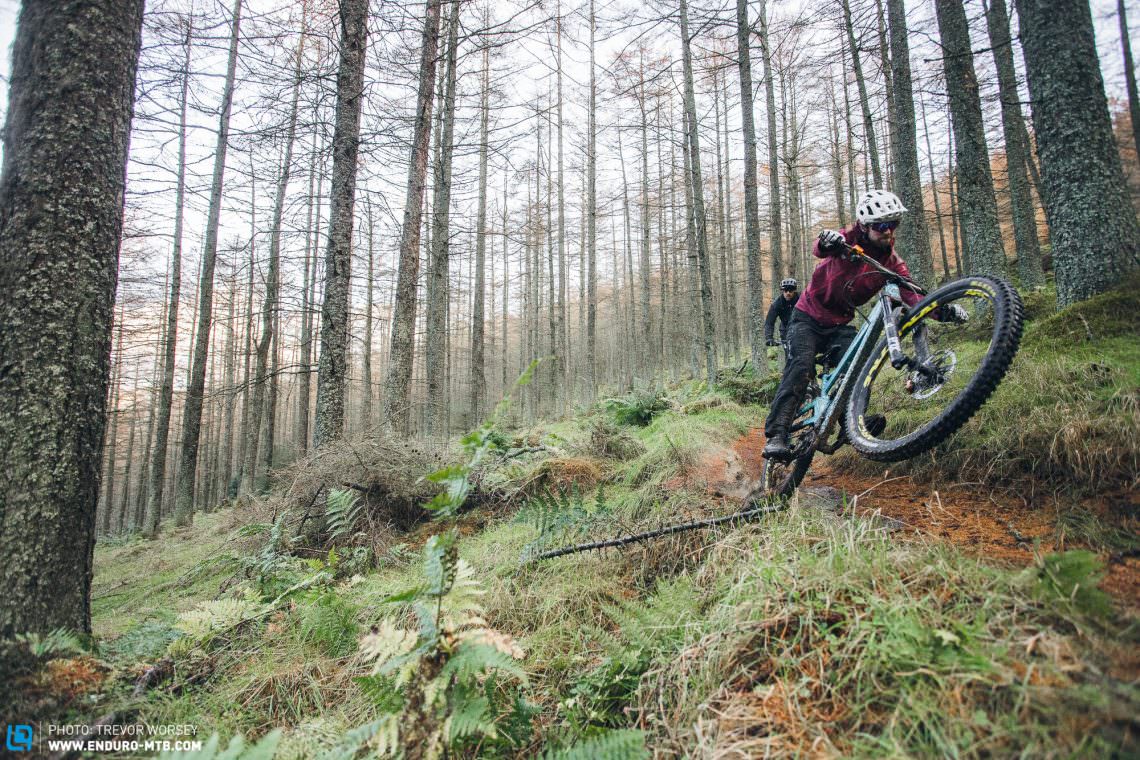
How we tested them
Each of the jackets was heavily used and abused, not only on filthy Scottish days, but also on unseasonably hot days to test the venting and breathability. Each jacket racked up some serious trail miles, was left wet in kit bags and sent through the washing machine multiple times to test the quality of the stitching and materials.
Tops and Flops
Tops

The small pack size and high levels of protection made the GORE C5 Active Trail a jacket in high demand amongst the test team. After many big rides it’s still looking great
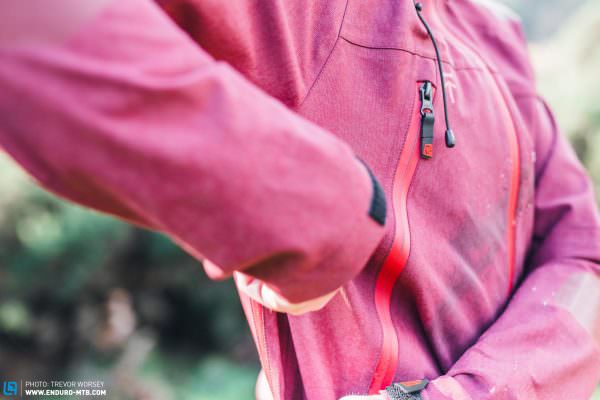
Tough material
We loved the rugged construction of the Leatt DBX 5.0. When you buy a premium jacket you want it to last. The Leatt DBX 5.0 took some big hits without complaint
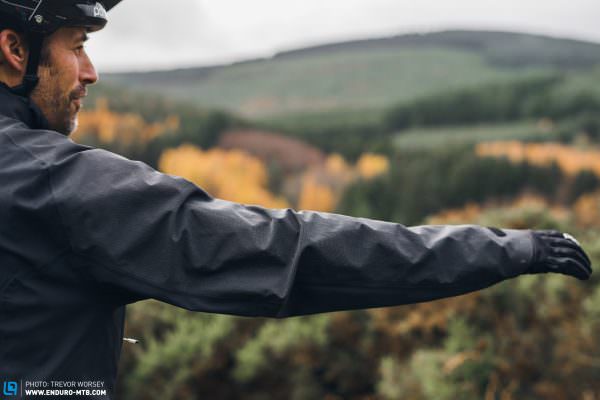
The Vectran coating on the POC Resistance Pro Jacket sleeves is proving phenomenally tough. Despite our best efforts to kill the fabric, it is still unscathed
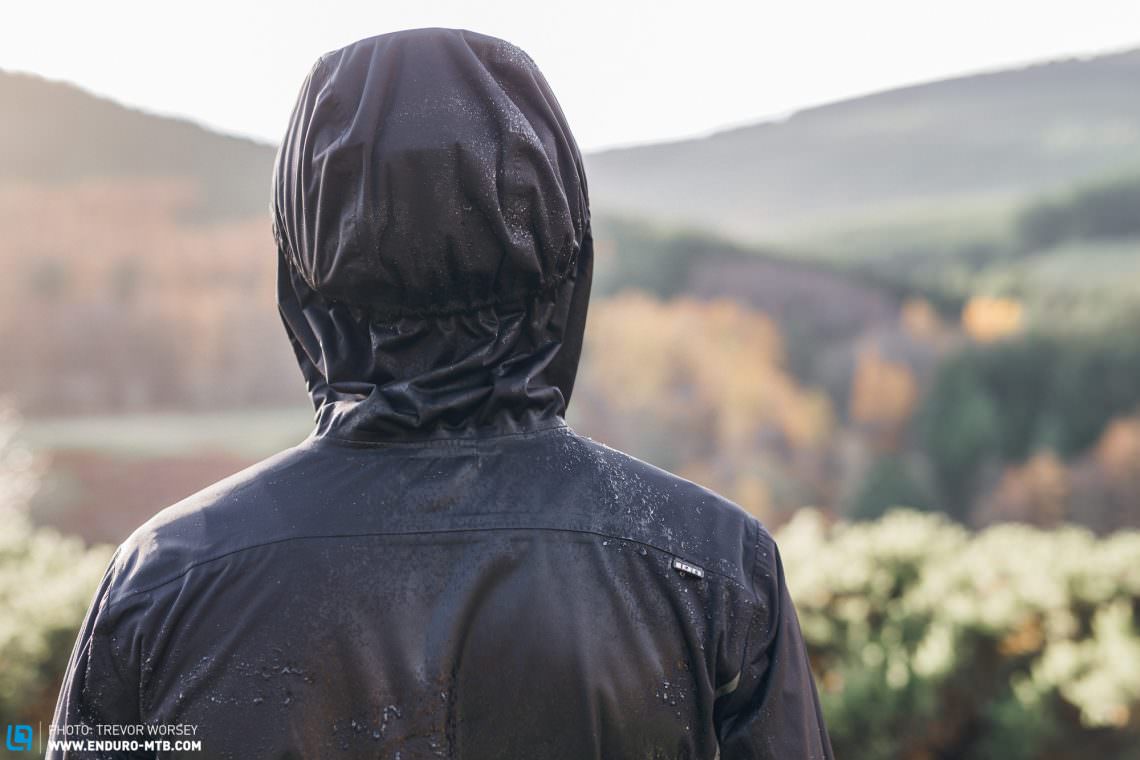
We loved the self-adjusting hood on the ION TRAZE SELECT, instantly conforming to our heads, no matter if we had a helmet on or not
Flops

We know that it’s supposed to help unzip the jacket with one hand, but the asymmetric zip on the FOX Attack Pro Water Jacket just looks odd to us, and you will spend a lot of your ride talking about it
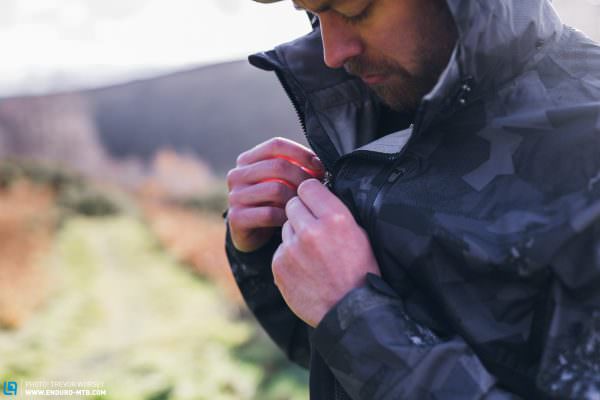
Nothing is worse at the end of a big ride than being stuck in your jacket, especially when your hands no longer work. Sometimes the panel designs make a zip more likely to jam with the inner shield. We frequently got stuck inside the Endura Singletrack II jacket.
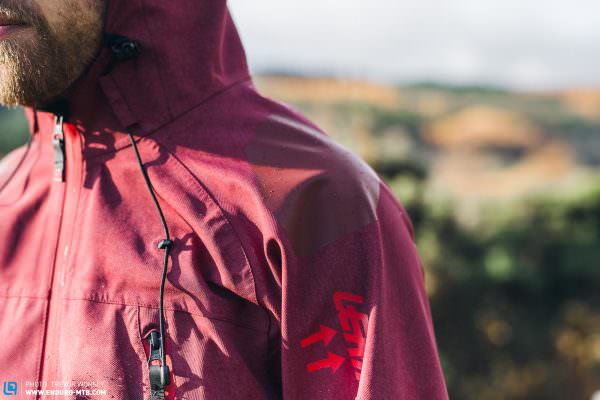
The pull toggles on the Leatt DBX 5.0 are slightly elastic. This makes the fit more comfortable, but due to their positioning, if you pull them and let them go by accident they comically hit you in the eye
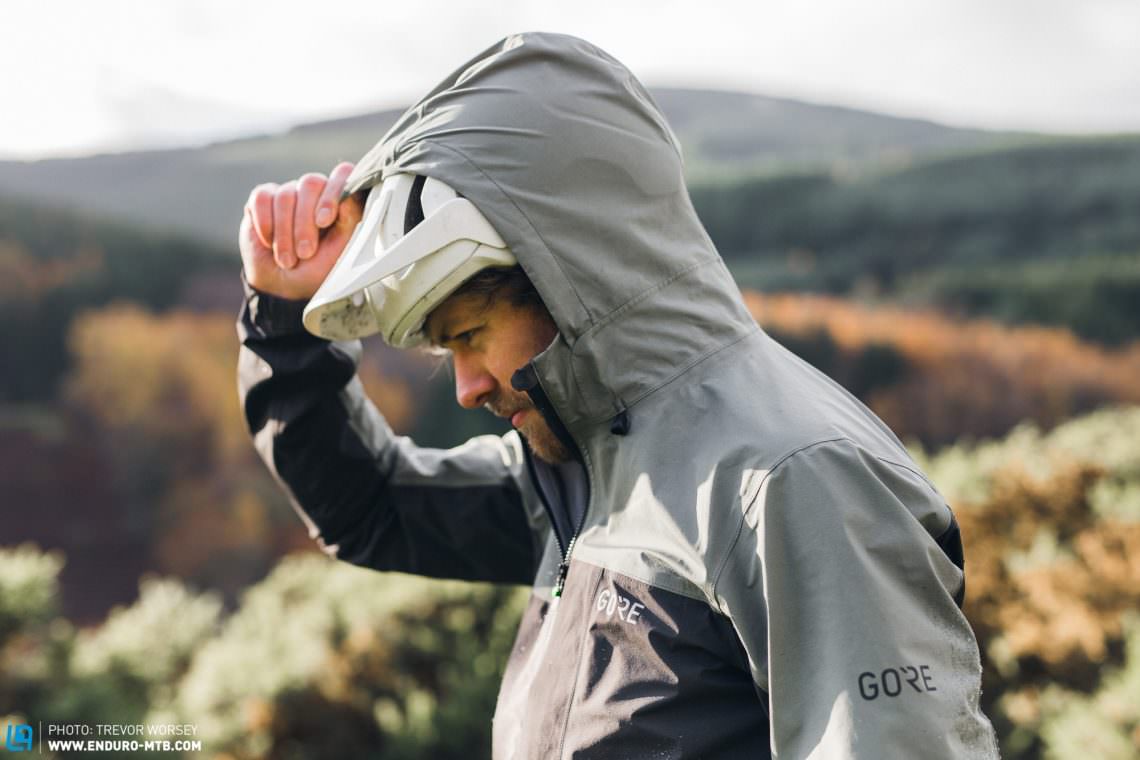
We loved the GORE C5 Active Trail jacket, the perfect blend of minimalist design and high-performance. Only the small hood let it down, sadly too small to throw over a helmet
So what’s the verdict?
So which jacket is best? It’s a tough one as it really depends on what you want from your jacket. If you’re more of a stuff-a-jacket-in-case of rain you will prioritise a jacket that is highly packable, with enough protection to enjoy the rest of the ride. Our favourite was the GORE C5 Active Trail. Only the lack of a helmet compatible hood stopped it dominating in our test, but it’s our top recommendation for a ‘stash-and-go jacket’. As a rough-and-ready, ‘screw the weather’ jacket, we loved the no-frills functionality and great design of the Endura Singletrack II jacket, which took our Best Value tip. If you want a ‘proper’ mountain jacket for big winter missions into the hills, where you may face constant rain, you will need a higher specification jacket.
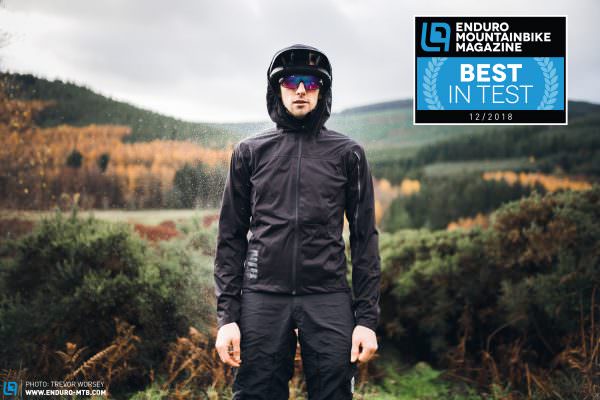
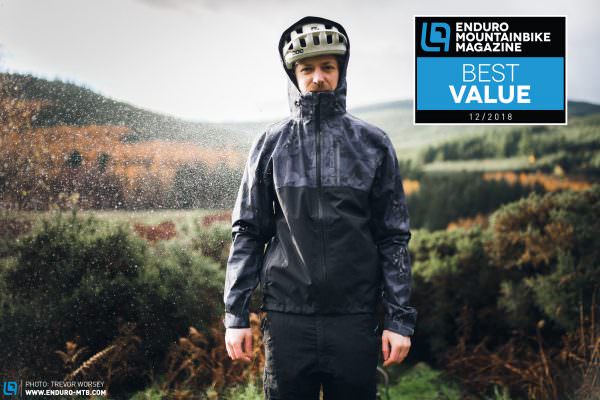
For truly horrible weather, we all wanted to be in the protective cocoons of either the Endura MT500 II or the Leatt DBX 5.0. The rugged Leatt DBX 5.0 is the perfect armour for those who value durability, but the lighter and more packable Endura MT500 II is more than a match for any winter. In this test though, the jacket needed to be a versatile year round option. We loved the easy packability of the SCOTT Trail MTN Dryo 20 but it was the increased protection of the ION SCRUB AMP that stole the top honours. With a great hood, robust weather protection and relaxed styling the ION SCRUB AMP was the most popular jacket with our team. ION takes the Best in Test.
Table of Contents
- Overview
- Best in test ION SCRUB AMP
- Best Value Endura Singletrack II Jacket
- Endura MT500 Waterproof Jacket II
- Fox Attack Pro Water Jacket
- GORE C5 Active Trail Hooded Jacket
- ION TRAZE SELECT
- Leatt DBX 5.0
- Madison DTE 3-Layer Storm Jacket
- Maloja AndriM
- POC Resistance Pro Enduro
- SCOTT Trail MTN Dryo 20
- Specialized Deflect H20
- Sweet Protection Hunter DryZeal Jacket











